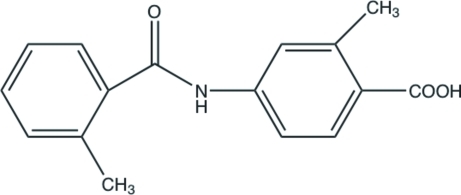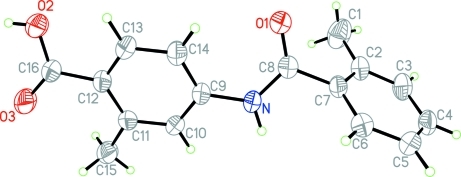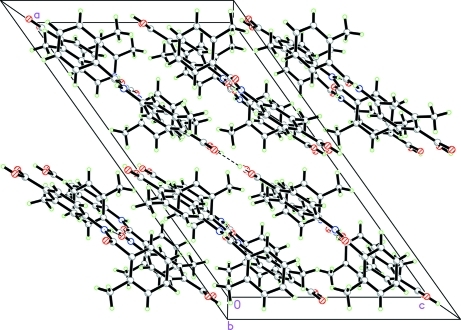Abstract
In the crystal structure of the title compound, C16H15NO3, intermolecular N—H⋯O hydrogen bonds link the molecules into chains parallel to the b axis and pairs of intermolecular O—H⋯O hydrogen bonds between inversion-related carboxylic acid groups link the molecules into dimers. The dihedral angle between the two benzene rings is 82.4 (2)°.
Related literature
For the use of the title compound as an intermediate in the preparation of pharmaceutically active benzazepine compounds that have vasopressin antagonistic activity, see: Yasuhiro et al. (2007 ▶). For the preparation of the title compound, see: Yasuhiro et al. (2000 ▶). For bond-length data, see: Allen et al. (1987 ▶).
Experimental
Crystal data
C16H15NO3
M r = 269.29
Monoclinic,

a = 23.318 (9) Å
b = 10.230 (2) Å
c = 13.901 (3) Å
β = 125.50 (3)°
V = 2699.7 (16) Å3
Z = 8
Mo Kα radiation
μ = 0.09 mm−1
T = 293 K
0.20 × 0.10 × 0.10 mm
Data collection
Enraf–Nonius CAD-4 diffractometer
Absorption correction: ψ scan (North et al., 1968 ▶) T min = 0.982, T max = 0.991
4968 measured reflections
2493 independent reflections
1641 reflections with I > 2σ(I)
R int = 0.034
3 standard reflections every 120 min intensity decay: 1%
Refinement
R[F 2 > 2σ(F 2)] = 0.047
wR(F 2) = 0.138
S = 1.00
2493 reflections
184 parameters
H-atom parameters constrained
Δρmax = 0.19 e Å−3
Δρmin = −0.18 e Å−3
Data collection: CAD-4 EXPRESS (Enraf–Nonius, 1989 ▶); cell refinement: CAD-4 EXPRESS; data reduction: XCAD4 (Harms & Wocadlo, 1995 ▶); program(s) used to solve structure: SHELXS97 (Sheldrick, 2008 ▶); program(s) used to refine structure: SHELXL97 (Sheldrick, 2008 ▶); molecular graphics: SHELXTL (Sheldrick, 2008 ▶); software used to prepare material for publication: PLATON (Spek, 2009) ▶.
Supplementary Material
Crystal structure: contains datablocks global, I. DOI: 10.1107/S160053681101110X/pk2306sup1.cif
Structure factors: contains datablocks I. DOI: 10.1107/S160053681101110X/pk2306Isup2.hkl
Additional supplementary materials: crystallographic information; 3D view; checkCIF report
Table 1. Hydrogen-bond geometry (Å, °).
| D—H⋯A | D—H | H⋯A | D⋯A | D—H⋯A |
|---|---|---|---|---|
| N—H0A⋯O1i | 0.86 | 2.23 | 3.076 (3) | 169 |
| O2—H2A⋯O3ii | 0.82 | 1.82 | 2.636 (4) | 174 |
Symmetry codes: (i)  ; (ii)
; (ii)  .
.
supplementary crystallographic information
Comment
The title compound, 2-methyl-4-(2-methylbenzamido)benzoic acid, or salts thereof are useful as intermediates for preparing pharmaceutically active benzazepine compounds that have vasopressin antagonistic activity. (Yasuhiro et al. 2007).
In the molecule of 2-methyl-4-(2-methylbenzamido)benzoic acid (Fig. 1), the bond lengths (Allen et al., 1987) and angles are within normal ranges. Intermolecular N-H···O hydrogen bonds link the molecules parallel to the b axis and pairs of intermolecular N-H···O hydrogen bonds link the molecules parallel to the b axis and pairs of intermolecular O-H···O hydrogen bonds between inversion related (x,y,z & 1-x,2-y,-z) carboxylic acid groups link the molecules into dimers. The dihedral angle between the two benzene rings is 82.39 (19) ° (Fig. 2).
Experimental
The title compound, 2-methyl-4-(2-methylbenzamido)benzoic acid was prepared by the literature method (Yasuhiro et al. 2000). Recrystallization of the of the crude crystalline product gave a yield of 81%. Crystals suitable for X-ray analysis were obtained by slow evaporation of a solution in methanol.
Refinement
H atoms were positioned geometrically, with N-H = 0.86 Å (for NH) and O-H =0.82 Å (for OH) and C-H = 0.93, 0.98 and 0.96 Å for aromatic, methine and methyl H, respectively. They were constrained to ride on their parent atoms, with Uiso(H) values set to either 1.2Ueq or 1.5Ueq (RCH3, OH) of the attached atom.
Figures
Fig. 1.
The molecular structure of the title compound, with displacement ellipsoids drawn at the 50% probability level.
Fig. 2.
A packing diagram of 2-methyl-4-(2-methylbenzamido)benzoic acid viewed down the b axis. Hydrogen bonds are shown as dashed lines.
Crystal data
| C16H15NO3 | F(000) = 1136 |
| Mr = 269.29 | Dx = 1.325 Mg m−3 |
| Monoclinic, C2/c | Melting point: 497 K |
| Hall symbol: -C 2yc | Mo Kα radiation, λ = 0.71073 Å |
| a = 23.318 (9) Å | Cell parameters from 25 reflections |
| b = 10.230 (2) Å | θ = 9–13° |
| c = 13.901 (3) Å | µ = 0.09 mm−1 |
| β = 125.50 (3)° | T = 293 K |
| V = 2699.7 (16) Å3 | Block, colourless |
| Z = 8 | 0.20 × 0.10 × 0.10 mm |
Data collection
| Enraf–Nonius CAD-4 diffractometer | 1641 reflections with I > 2σ(I) |
| Radiation source: fine-focus sealed tube | Rint = 0.034 |
| graphite | θmax = 25.4°, θmin = 2.2° |
| ω/2θ scans | h = −28→28 |
| Absorption correction: ψ scan (North et al., 1968) | k = 0→12 |
| Tmin = 0.982, Tmax = 0.991 | l = −16→16 |
| 4968 measured reflections | 3 standard reflections every 120 min |
| 2493 independent reflections | intensity decay: 1% |
Refinement
| Refinement on F2 | Secondary atom site location: difference Fourier map |
| Least-squares matrix: full | Hydrogen site location: inferred from neighbouring sites |
| R[F2 > 2σ(F2)] = 0.047 | H-atom parameters constrained |
| wR(F2) = 0.138 | w = 1/[σ2(Fo2) + (0.075P)2] where P = (Fo2 + 2Fc2)/3 |
| S = 1.00 | (Δ/σ)max < 0.001 |
| 2493 reflections | Δρmax = 0.19 e Å−3 |
| 184 parameters | Δρmin = −0.18 e Å−3 |
| 0 restraints | Extinction correction: SHELXL, Fc*=kFc[1+0.001xFc2λ3/sin(2θ)]-1/4 |
| Primary atom site location: structure-invariant direct methods | Extinction coefficient: 0.0023 (5) |
Special details
| Geometry. All esds (except the esd in the dihedral angle between two l.s. planes) are estimated using the full covariance matrix. The cell esds are taken into account individually in the estimation of esds in distances, angles and torsion angles; correlations between esds in cell parameters are only used when they are defined by crystal symmetry. An approximate (isotropic) treatment of cell esds is used for estimating esds involving l.s. planes. |
| Refinement. Refinement of F2 against ALL reflections. The weighted R-factor wR and goodness of fit S are based on F2, conventional R-factors R are based on F, with F set to zero for negative F2. The threshold expression of F2 > 2σ(F2) is used only for calculating R-factors(gt) etc. and is not relevant to the choice of reflections for refinement. R-factors based on F2 are statistically about twice as large as those based on F, and R- factors based on ALL data will be even larger. |
Fractional atomic coordinates and isotropic or equivalent isotropic displacement parameters (Å2)
| x | y | z | Uiso*/Ueq | ||
| N | 0.27879 (10) | 1.06074 (17) | 0.23814 (17) | 0.0431 (5) | |
| H0A | 0.2725 | 1.1380 | 0.2547 | 0.052* | |
| O1 | 0.25277 (9) | 0.84642 (15) | 0.23884 (17) | 0.0573 (5) | |
| C1 | 0.09320 (14) | 0.8941 (3) | 0.0956 (2) | 0.0698 (8) | |
| H1A | 0.0432 | 0.8865 | 0.0559 | 0.105* | |
| H1B | 0.1141 | 0.8086 | 0.1159 | 0.105* | |
| H1C | 0.1026 | 0.9364 | 0.0445 | 0.105* | |
| O2 | 0.45652 (10) | 0.90523 (16) | 0.04728 (17) | 0.0639 (6) | |
| H2A | 0.4798 | 0.9040 | 0.0202 | 0.096* | |
| C2 | 0.12408 (12) | 0.9737 (2) | 0.2061 (2) | 0.0432 (6) | |
| O3 | 0.46865 (10) | 1.11880 (17) | 0.03858 (18) | 0.0662 (6) | |
| C3 | 0.08066 (13) | 1.0191 (2) | 0.2371 (2) | 0.0507 (7) | |
| H3A | 0.0328 | 1.0002 | 0.1884 | 0.061* | |
| C4 | 0.10675 (14) | 1.0914 (2) | 0.3382 (2) | 0.0496 (7) | |
| H4A | 0.0764 | 1.1214 | 0.3562 | 0.060* | |
| C5 | 0.17705 (14) | 1.1195 (2) | 0.4121 (2) | 0.0490 (6) | |
| H5A | 0.1949 | 1.1656 | 0.4818 | 0.059* | |
| C6 | 0.22118 (12) | 1.0787 (2) | 0.3823 (2) | 0.0440 (6) | |
| H6A | 0.2688 | 1.0997 | 0.4312 | 0.053* | |
| C7 | 0.19543 (12) | 1.0070 (2) | 0.2804 (2) | 0.0372 (5) | |
| C8 | 0.24493 (12) | 0.9618 (2) | 0.2510 (2) | 0.0400 (5) | |
| C9 | 0.32340 (11) | 1.0500 (2) | 0.2002 (2) | 0.0387 (5) | |
| C10 | 0.32865 (11) | 1.1578 (2) | 0.1449 (2) | 0.0420 (6) | |
| H10A | 0.3043 | 1.2335 | 0.1373 | 0.050* | |
| C11 | 0.36888 (12) | 1.1568 (2) | 0.1007 (2) | 0.0409 (6) | |
| C12 | 0.40456 (11) | 1.0408 (2) | 0.1123 (2) | 0.0404 (6) | |
| C13 | 0.39995 (12) | 0.9348 (2) | 0.1700 (2) | 0.0458 (6) | |
| H13A | 0.4244 | 0.8589 | 0.1787 | 0.055* | |
| C14 | 0.36050 (12) | 0.9378 (2) | 0.2148 (2) | 0.0459 (6) | |
| H14A | 0.3589 | 0.8657 | 0.2540 | 0.055* | |
| C15 | 0.37002 (14) | 1.2772 (2) | 0.0391 (2) | 0.0555 (7) | |
| H15A | 0.3369 | 1.3400 | 0.0312 | 0.083* | |
| H15B | 0.3574 | 1.2538 | −0.0378 | 0.083* | |
| H15C | 0.4164 | 1.3144 | 0.0848 | 0.083* | |
| C16 | 0.44573 (12) | 1.0256 (2) | 0.0627 (2) | 0.0452 (6) |
Atomic displacement parameters (Å2)
| U11 | U22 | U33 | U12 | U13 | U23 | |
| N | 0.0528 (12) | 0.0369 (10) | 0.0640 (13) | −0.0009 (9) | 0.0480 (11) | −0.0035 (9) |
| O1 | 0.0742 (12) | 0.0373 (9) | 0.0957 (14) | −0.0002 (8) | 0.0695 (12) | −0.0015 (9) |
| C1 | 0.0601 (18) | 0.098 (2) | 0.0525 (17) | −0.0085 (16) | 0.0333 (15) | −0.0222 (16) |
| O2 | 0.0834 (13) | 0.0489 (10) | 0.1041 (15) | −0.0071 (9) | 0.0799 (13) | −0.0164 (10) |
| C2 | 0.0471 (14) | 0.0498 (14) | 0.0434 (14) | −0.0013 (11) | 0.0324 (12) | 0.0026 (11) |
| O3 | 0.0883 (14) | 0.0514 (11) | 0.1102 (16) | −0.0040 (9) | 0.0870 (14) | −0.0038 (10) |
| C3 | 0.0415 (14) | 0.0655 (16) | 0.0562 (16) | 0.0015 (12) | 0.0348 (13) | 0.0037 (13) |
| C4 | 0.0609 (16) | 0.0479 (14) | 0.0690 (17) | 0.0030 (12) | 0.0542 (15) | 0.0028 (13) |
| C5 | 0.0685 (17) | 0.0427 (13) | 0.0559 (16) | −0.0053 (12) | 0.0476 (15) | −0.0077 (11) |
| C6 | 0.0479 (14) | 0.0427 (13) | 0.0512 (15) | −0.0059 (11) | 0.0344 (13) | −0.0044 (11) |
| C7 | 0.0451 (13) | 0.0355 (11) | 0.0451 (13) | 0.0019 (10) | 0.0342 (12) | 0.0042 (10) |
| C8 | 0.0438 (13) | 0.0395 (13) | 0.0471 (13) | −0.0004 (10) | 0.0324 (12) | −0.0003 (10) |
| C9 | 0.0408 (12) | 0.0395 (12) | 0.0493 (14) | −0.0042 (10) | 0.0339 (12) | −0.0061 (10) |
| C10 | 0.0490 (14) | 0.0334 (12) | 0.0606 (15) | −0.0011 (10) | 0.0416 (13) | −0.0061 (11) |
| C11 | 0.0466 (13) | 0.0371 (12) | 0.0522 (14) | −0.0085 (10) | 0.0362 (12) | −0.0096 (11) |
| C12 | 0.0412 (13) | 0.0423 (13) | 0.0511 (14) | −0.0057 (10) | 0.0344 (12) | −0.0081 (11) |
| C13 | 0.0477 (14) | 0.0400 (12) | 0.0665 (17) | 0.0055 (10) | 0.0426 (14) | −0.0009 (11) |
| C14 | 0.0498 (14) | 0.0413 (13) | 0.0655 (16) | 0.0021 (11) | 0.0442 (14) | 0.0040 (12) |
| C15 | 0.0724 (18) | 0.0418 (14) | 0.0803 (19) | 0.0006 (12) | 0.0603 (16) | 0.0031 (13) |
| C16 | 0.0472 (14) | 0.0442 (13) | 0.0595 (16) | −0.0033 (11) | 0.0398 (13) | −0.0101 (12) |
Geometric parameters (Å, °)
| N—C8 | 1.357 (3) | C5—H5A | 0.9300 |
| N—C9 | 1.417 (3) | C6—C7 | 1.386 (3) |
| N—H0A | 0.8600 | C6—H6A | 0.9300 |
| O1—C8 | 1.221 (3) | C7—C8 | 1.503 (3) |
| C1—C2 | 1.501 (3) | C9—C14 | 1.380 (3) |
| C1—H1A | 0.9600 | C9—C10 | 1.389 (3) |
| C1—H1B | 0.9600 | C10—C11 | 1.389 (3) |
| C1—H1C | 0.9600 | C10—H10A | 0.9300 |
| O2—C16 | 1.300 (3) | C11—C12 | 1.404 (3) |
| O2—H2A | 0.8200 | C11—C15 | 1.509 (3) |
| C2—C3 | 1.391 (3) | C12—C13 | 1.388 (3) |
| C2—C7 | 1.398 (3) | C12—C16 | 1.481 (3) |
| O3—C16 | 1.230 (3) | C13—C14 | 1.379 (3) |
| C3—C4 | 1.378 (4) | C13—H13A | 0.9300 |
| C3—H3A | 0.9300 | C14—H14A | 0.9300 |
| C4—C5 | 1.367 (4) | C15—H15A | 0.9600 |
| C4—H4A | 0.9300 | C15—H15B | 0.9600 |
| C5—C6 | 1.378 (3) | C15—H15C | 0.9600 |
| C8—N—C9 | 126.85 (18) | O1—C8—C7 | 122.33 (19) |
| C8—N—H0A | 116.6 | N—C8—C7 | 113.80 (18) |
| C9—N—H0A | 116.6 | C14—C9—C10 | 119.50 (19) |
| C2—C1—H1A | 109.5 | C14—C9—N | 122.87 (19) |
| C2—C1—H1B | 109.5 | C10—C9—N | 117.63 (18) |
| H1A—C1—H1B | 109.5 | C11—C10—C9 | 122.6 (2) |
| C2—C1—H1C | 109.5 | C11—C10—H10A | 118.7 |
| H1A—C1—H1C | 109.5 | C9—C10—H10A | 118.7 |
| H1B—C1—H1C | 109.5 | C10—C11—C12 | 117.56 (19) |
| C16—O2—H2A | 109.5 | C10—C11—C15 | 118.97 (19) |
| C3—C2—C7 | 117.3 (2) | C12—C11—C15 | 123.43 (18) |
| C3—C2—C1 | 119.7 (2) | C13—C12—C11 | 119.16 (18) |
| C7—C2—C1 | 123.1 (2) | C13—C12—C16 | 118.4 (2) |
| C4—C3—C2 | 121.7 (2) | C11—C12—C16 | 122.4 (2) |
| C4—C3—H3A | 119.1 | C14—C13—C12 | 122.6 (2) |
| C2—C3—H3A | 119.1 | C14—C13—H13A | 118.7 |
| C5—C4—C3 | 120.4 (2) | C12—C13—H13A | 118.7 |
| C5—C4—H4A | 119.8 | C13—C14—C9 | 118.5 (2) |
| C3—C4—H4A | 119.8 | C13—C14—H14A | 120.7 |
| C4—C5—C6 | 119.3 (2) | C9—C14—H14A | 120.7 |
| C4—C5—H5A | 120.4 | C11—C15—H15A | 109.5 |
| C6—C5—H5A | 120.4 | C11—C15—H15B | 109.5 |
| C5—C6—C7 | 120.8 (2) | H15A—C15—H15B | 109.5 |
| C5—C6—H6A | 119.6 | C11—C15—H15C | 109.5 |
| C7—C6—H6A | 119.6 | H15A—C15—H15C | 109.5 |
| C6—C7—C2 | 120.50 (19) | H15B—C15—H15C | 109.5 |
| C6—C7—C8 | 119.7 (2) | O3—C16—O2 | 122.23 (19) |
| C2—C7—C8 | 119.8 (2) | O3—C16—C12 | 123.2 (2) |
| O1—C8—N | 123.87 (19) | O2—C16—C12 | 114.6 (2) |
| C7—C2—C3—C4 | −1.5 (3) | C8—N—C9—C10 | 152.9 (2) |
| C1—C2—C3—C4 | 179.4 (2) | C14—C9—C10—C11 | 1.5 (3) |
| C2—C3—C4—C5 | −0.7 (4) | N—C9—C10—C11 | −177.8 (2) |
| C3—C4—C5—C6 | 2.4 (4) | C9—C10—C11—C12 | 0.7 (3) |
| C4—C5—C6—C7 | −1.8 (3) | C9—C10—C11—C15 | 178.4 (2) |
| C5—C6—C7—C2 | −0.5 (3) | C10—C11—C12—C13 | −2.0 (3) |
| C5—C6—C7—C8 | −179.0 (2) | C15—C11—C12—C13 | −179.6 (2) |
| C3—C2—C7—C6 | 2.1 (3) | C10—C11—C12—C16 | 176.5 (2) |
| C1—C2—C7—C6 | −178.8 (2) | C15—C11—C12—C16 | −1.2 (4) |
| C3—C2—C7—C8 | −179.5 (2) | C11—C12—C13—C14 | 1.2 (4) |
| C1—C2—C7—C8 | −0.4 (3) | C16—C12—C13—C14 | −177.3 (2) |
| C9—N—C8—O1 | 5.4 (4) | C12—C13—C14—C9 | 0.9 (4) |
| C9—N—C8—C7 | −173.8 (2) | C10—C9—C14—C13 | −2.2 (4) |
| C6—C7—C8—O1 | 121.0 (3) | N—C9—C14—C13 | 177.0 (2) |
| C2—C7—C8—O1 | −57.5 (3) | C13—C12—C16—O3 | −160.2 (2) |
| C6—C7—C8—N | −59.8 (3) | C11—C12—C16—O3 | 21.4 (4) |
| C2—C7—C8—N | 121.7 (2) | C13—C12—C16—O2 | 19.2 (3) |
| C8—N—C9—C14 | −26.4 (4) | C11—C12—C16—O2 | −159.2 (2) |
Hydrogen-bond geometry (Å, °)
| D—H···A | D—H | H···A | D···A | D—H···A |
| N—H0A···O1i | 0.86 | 2.23 | 3.076 (3) | 169 |
| O2—H2A···O3ii | 0.82 | 1.82 | 2.636 (4) | 174 |
Symmetry codes: (i) −x+1/2, y+1/2, −z+1/2; (ii) −x+1, −y+2, −z.
Footnotes
Supplementary data and figures for this paper are available from the IUCr electronic archives (Reference: PK2306).
References
- Allen, F. H., Kennard, O., Watson, D. G., Brammer, L., Orpen, A. G. & Taylor, R. (1987). J. Chem. Soc. Perkin Trans. 2, pp. S1–19.
- Enraf–Nonius (1989). CAD-4 EXPRESS Enraf–Nonius, Delft. The Netherlands.
- Harms, K. & Wocadlo, S. (1995). XCAD4 University of Marburg, Germany.
- North, A. C. T., Phillips, D. C. & Mathews, F. S. (1968). Acta Cryst. A24, 351–359.
- Sheldrick, G. M. (2008). Acta Cryst. A64, 112–122. [DOI] [PubMed]
- Spek, A. L. (2009). Acta Cryst D65, 148–155. [DOI] [PMC free article] [PubMed]
- Yasuhiro, T., Takao, N. & Jun-Ichi, M. (2000). Bioorg. Med. Chem. Lett. 10, 2493–2495.
- Yasuhiro, T., Takuya, F. & Takao, N. (2007). Bioorg. Med. Chem. Lett. 17, 6455–6458.
Associated Data
This section collects any data citations, data availability statements, or supplementary materials included in this article.
Supplementary Materials
Crystal structure: contains datablocks global, I. DOI: 10.1107/S160053681101110X/pk2306sup1.cif
Structure factors: contains datablocks I. DOI: 10.1107/S160053681101110X/pk2306Isup2.hkl
Additional supplementary materials: crystallographic information; 3D view; checkCIF report




